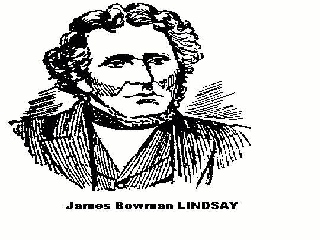

As a youngster living in the City of Dundee on the banks of the River Tay, in Scotland, I remember my father pointing out to me a plaque on the wall of a building and saying "that man sent messages across the Tay by wireless". In no way can I say that my interest in Radio started at that moment because it did not come to mind until I was reading the newsletter of the Museum of Communications and "that man" was mentioned in it.
James Bowman LINDSAY was born in Carmylie near to Arbroath, on the 8th of September, 1799, his parents being farm workers and he himself was apprenticed as a handloom weaver. He spent a lot of his time with his nose in a book reading, as he walked from Carmylie to Arbroath carrying a roll of cloth on his shoulders.
In 1821 he entered St. Andrews University in the town of that name, in the 'Wee Kingdom of Fife' and was up until that time more or less self educated. In 1829 he obtained the post of Lecturer in science and mathimatics at the James Watt institution in Dundee and settled in the City in1833 at the age of 34 years. He ran courses on frictional, galvanic and voltaic electricity as well as on magnetism and electro-magnetism.
In 1832 his experiments covered power, light and an electric telegraph which he demonstrated that year. He also prophesised the use of electricity to light and heat homes as well as drive machinery in industry. By 1835 he had a continuous light source working which remained alight even when covered by a sealed glass jar, had no smell was not affected by wind or water and could be lit without the use of a taper. The light was brighter than gaslight, but unfortunately no details of his dicovery are known today.
In 1845 LINDSAY suggested the Autographic telegraph, his idea being that a messsage could be sent down a wire in the form of a circuit and each wire would represent a letter or number read by a magnetic needle at the receive end, indicating the character. He later suggested that two wires would be enough and the return wires would be unnecessary if a large metal plate was immersed in the sea at either end of the circuit.. Here, in the return path, we have the first practical use of wire less telegraphy. LINDSAY also suggested a telegraphic dictionary where with the use of binary combinations, 24 simple signals could give 331,776 signals, more than all the words in dictionaries of that time. (Definitely a more complicated method than that of Samuel MORSE). According to LINDSAY's calculations a twentytwo word message would have taken fourtyfour seconds whether sent from Dundee to Arbroath, Calcutta or even Peking.
In1845 LINDSAY suggested how a submarine cable could join the Americas with the UK and any jointing would be done by 'electric welding '. To the best of our knowledge this is the first ever reference and application to electric welding known; another of his inventions it is believed.
The plaque on the wall that my Father showed me, celebrated a telegraphic transmission 2 miles across the River Tay not through the air but through the water with no wires involved. Demonstrations were done in the presence of well known scientists of the time such as Faraday, Airy, Lord Kelvin and others. LINDSAY took out a patent for his 'Transmarine Telegraph ' in 1854, which consisted of transmitting a telegraph message by means of electricity or magnetism through water without submerged wires, the water being the connecting medium.
Readin a paper on Telegraph without Wires, in 1859, LINDSAY' calculations meant a station in Cornwall and one in the north of Scotland with corresponding stations in the Americas would enable messages to be sent across the Atlantic. (By coincidence MARCONI also chose Cornwall for some of his experiments.
LINDSAY died in 1862, never having completed his main dream in life, that of a dictionary in 50 languages. Perhaps if he had spent more time in the electrical fields, MORSE AND MARCONI would never have had their day.
William PREECE, who was responsible for the telephone system in the UK said of LINDSAY's invention "unfortunately it happend that there was really no necessity for the invention in those days. An invention to be of use must come at the right time " This from the man who was one of the instigators of bringing MARCONI and his wire less system to Britain.
MARCONI himself said about LINDSAY " In any case the name of James Bowman LINDSAY must go down in posterity as that of the first man who thoroughly believed in the possibility and utility of long distance wire less telegraphy " (Statement from on board the S.Y. Elettra, 1925.) (References ... Scot's Mag. Telegraphy by A.H. Millar. Dundee Advertiser. Dundee Reference Library. British National Library. 'Transmitting' the newsletter of the Museum of Communications.) Jack Birse, G4ZVD.